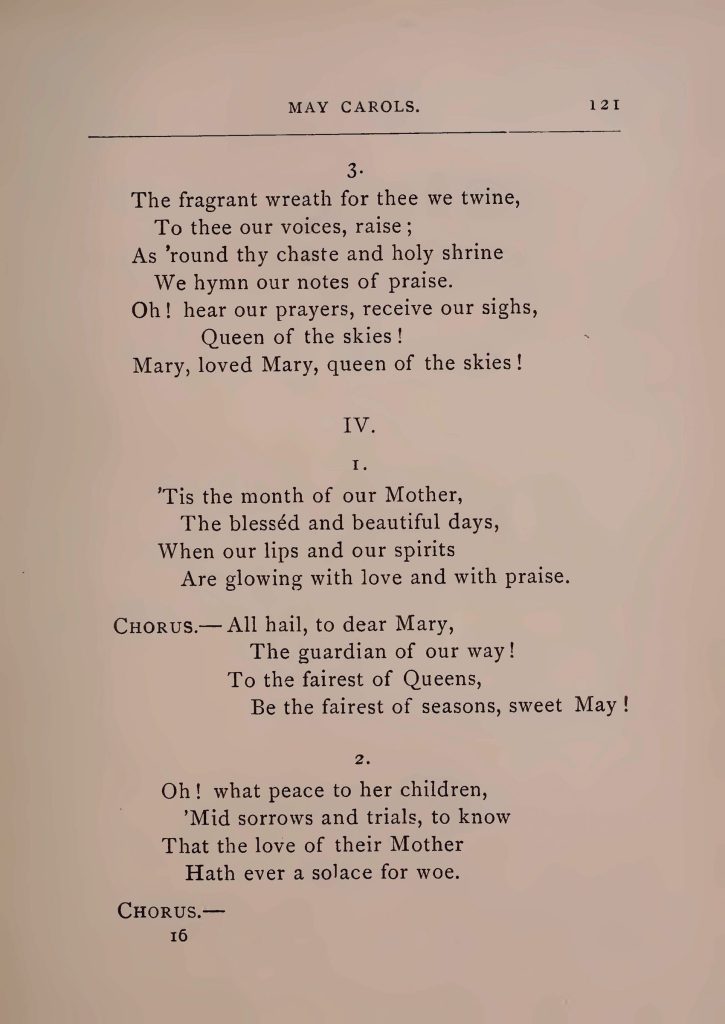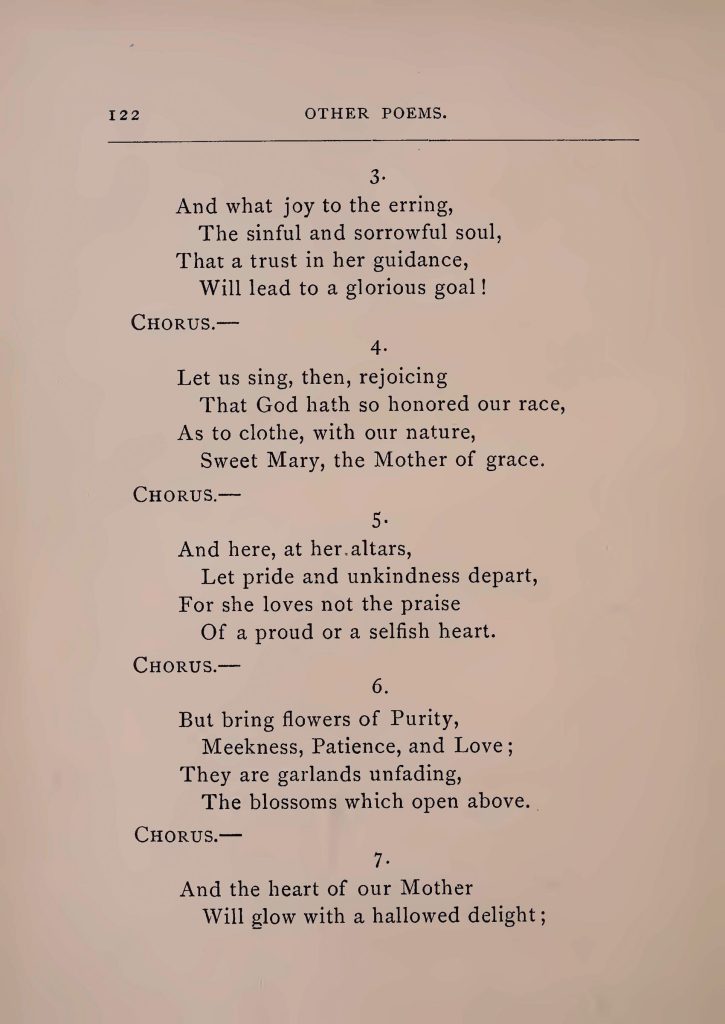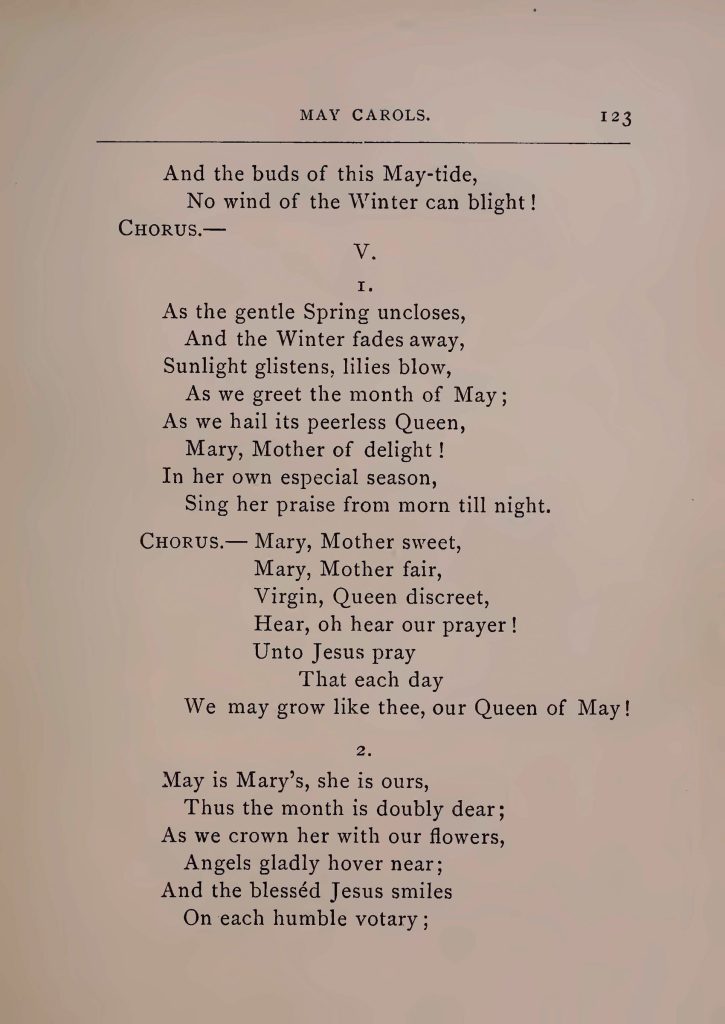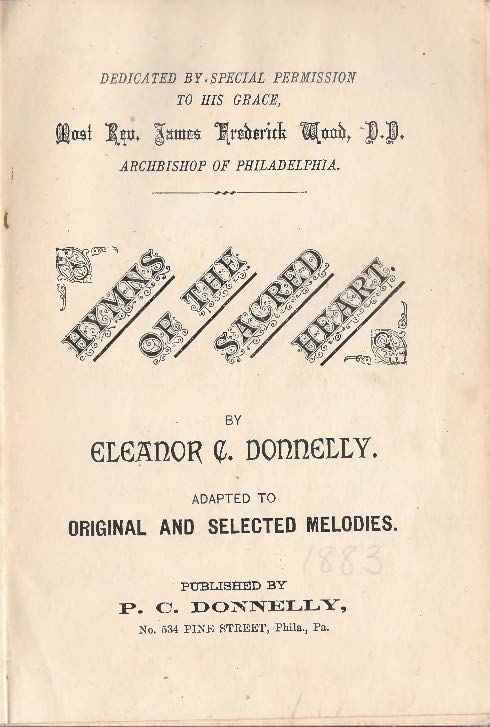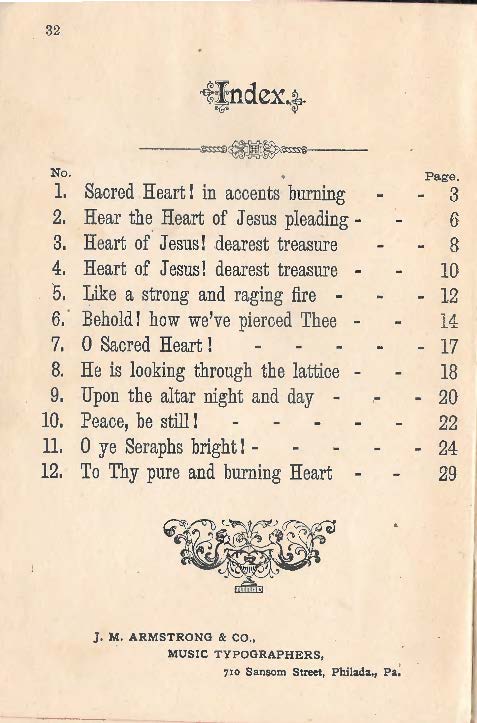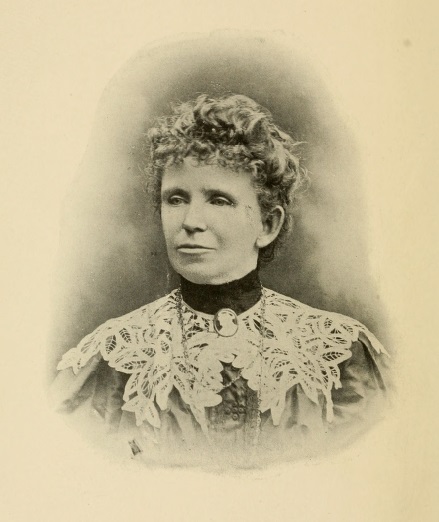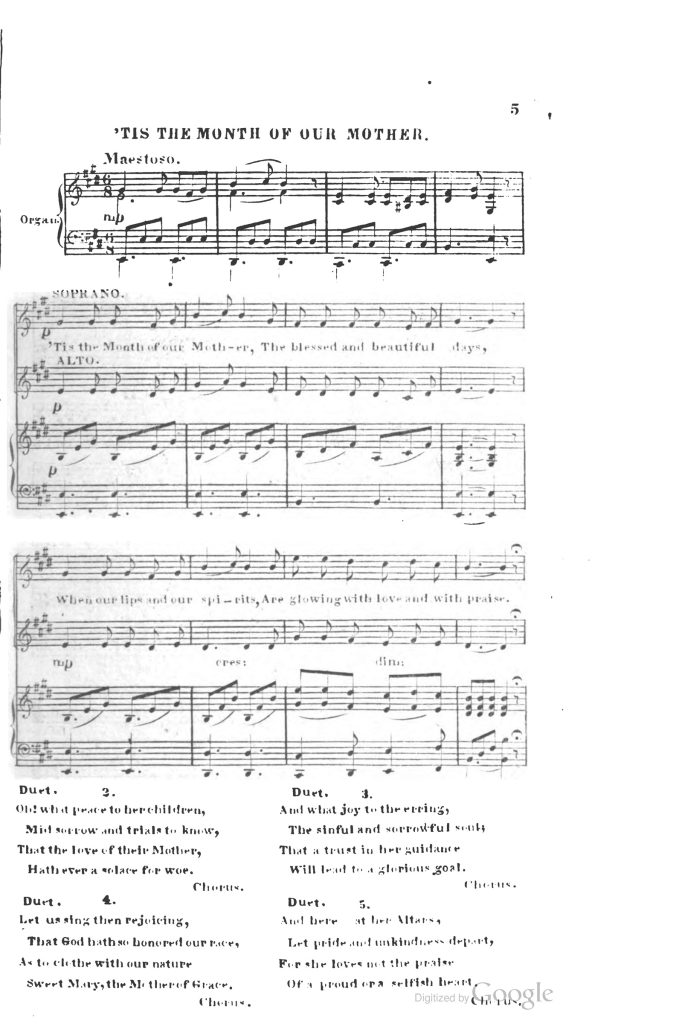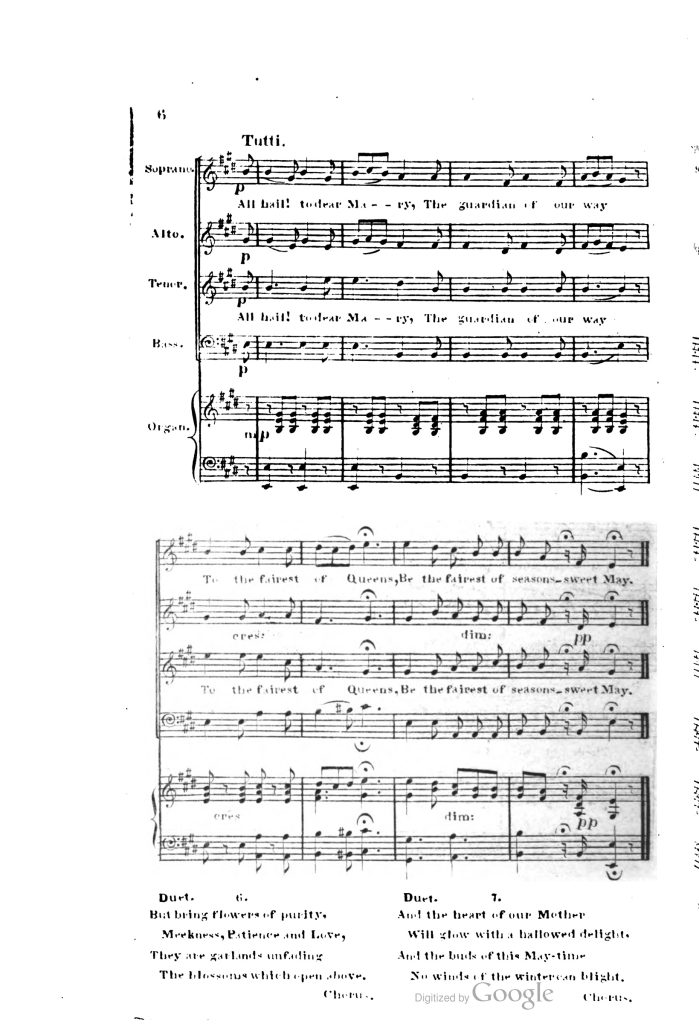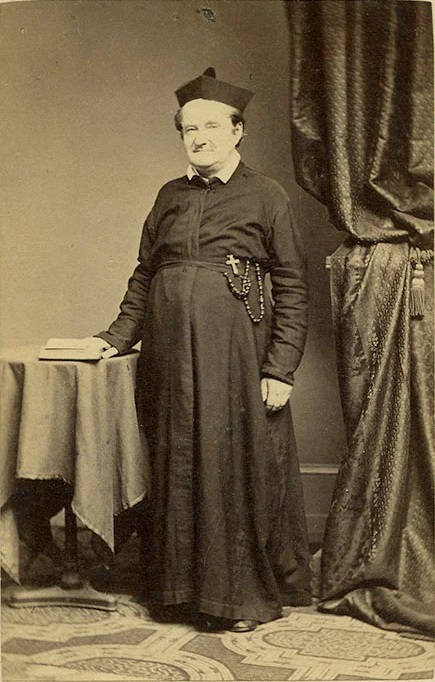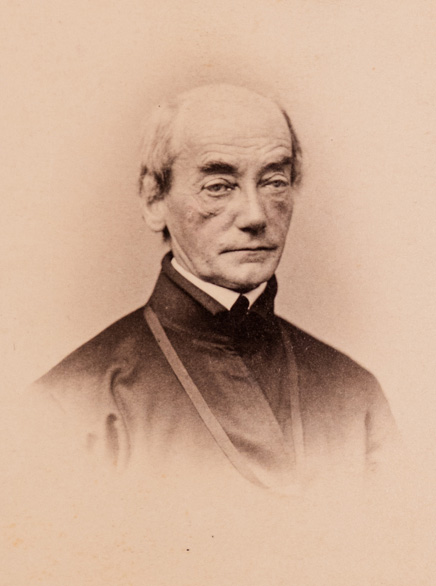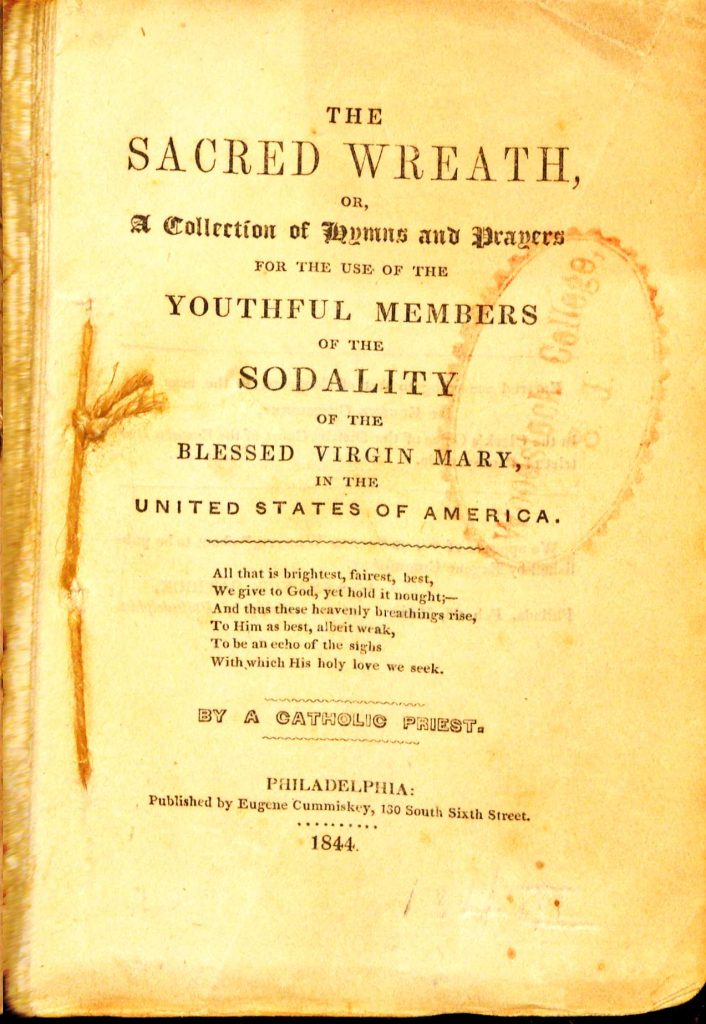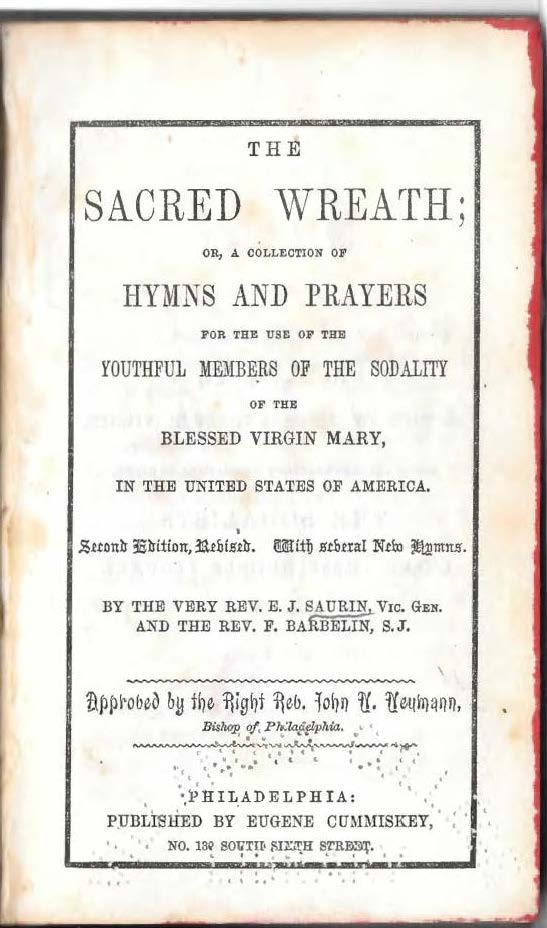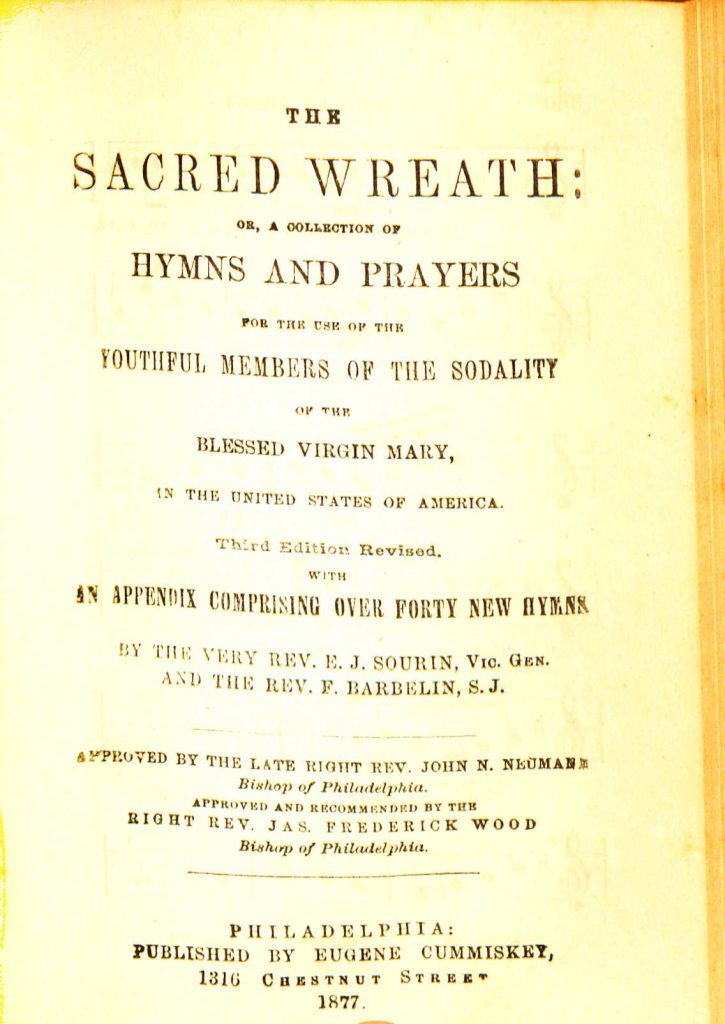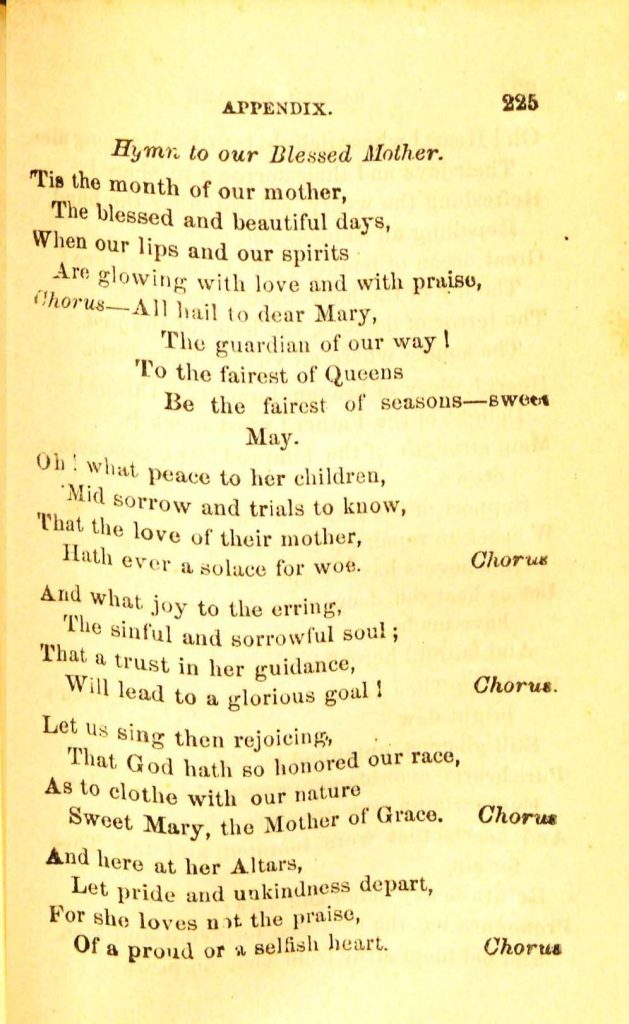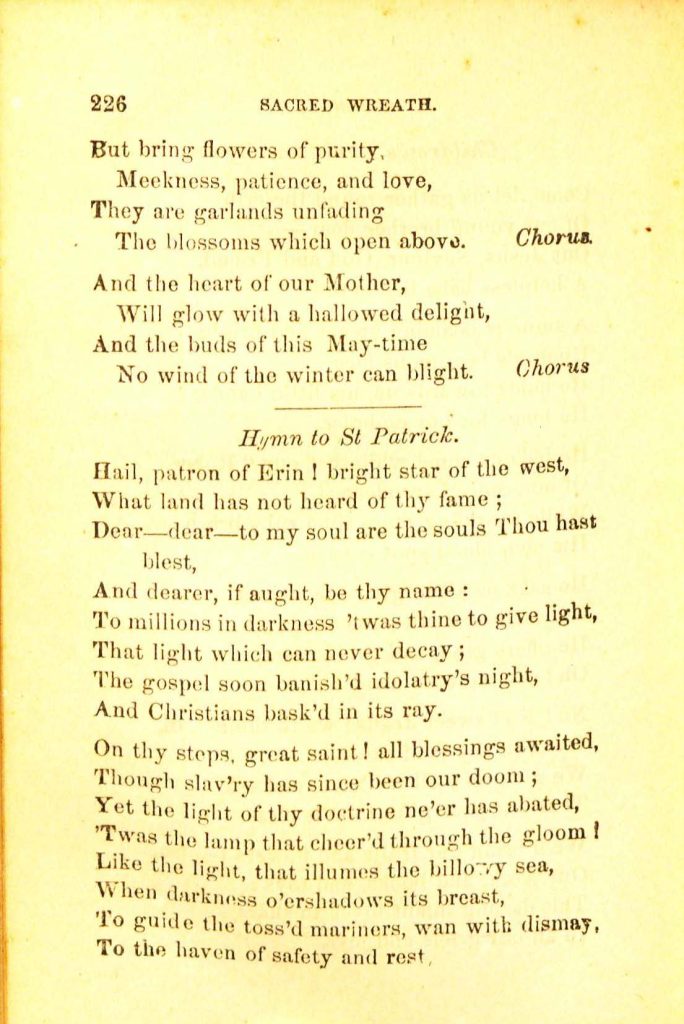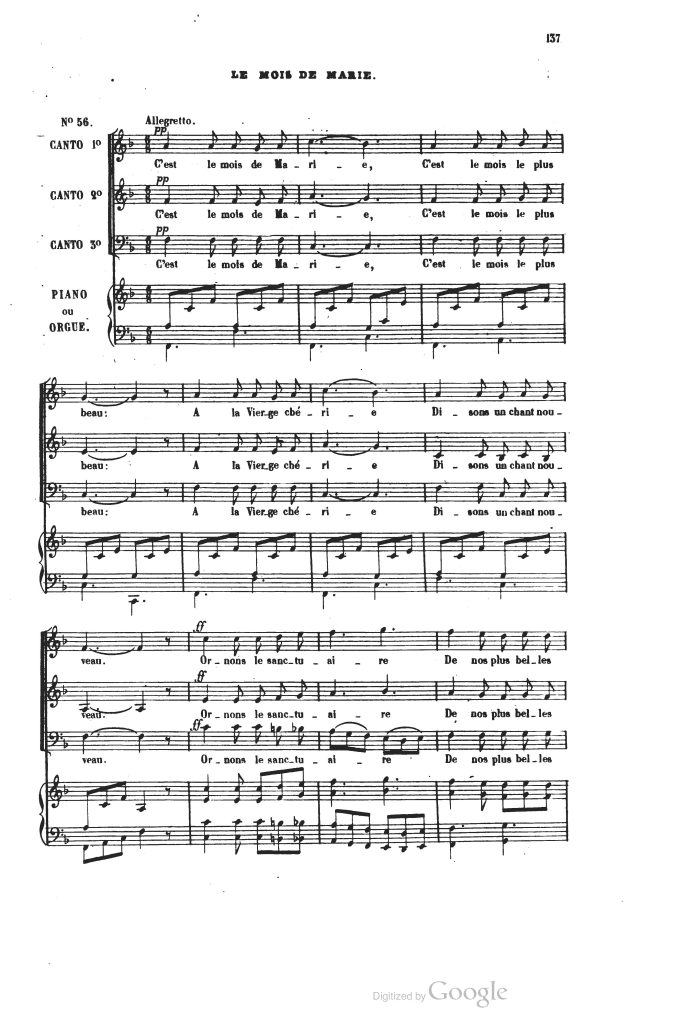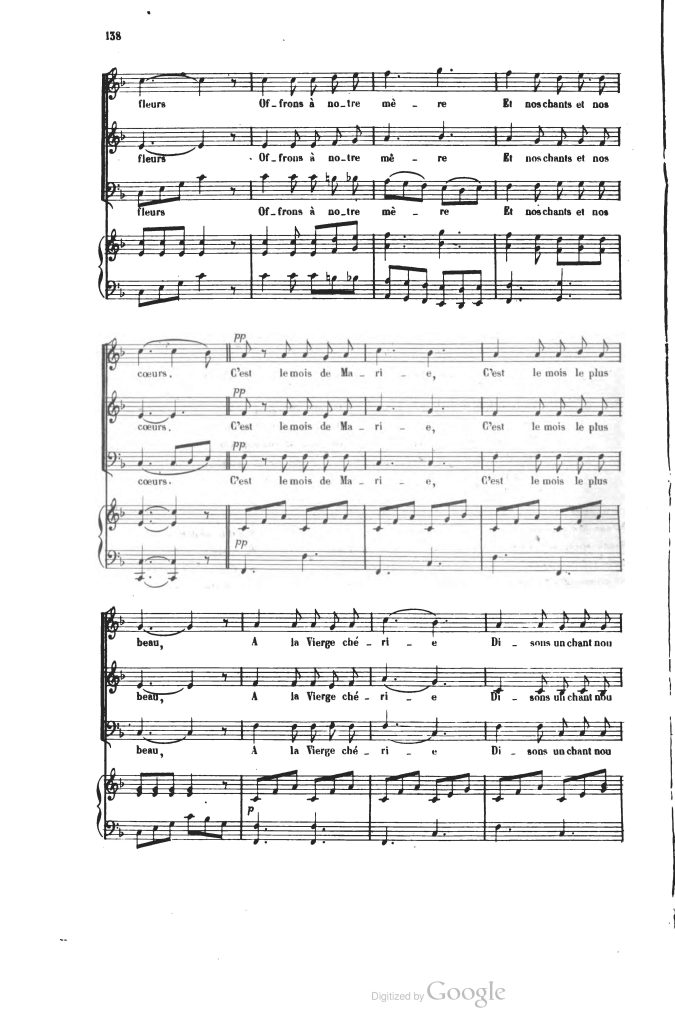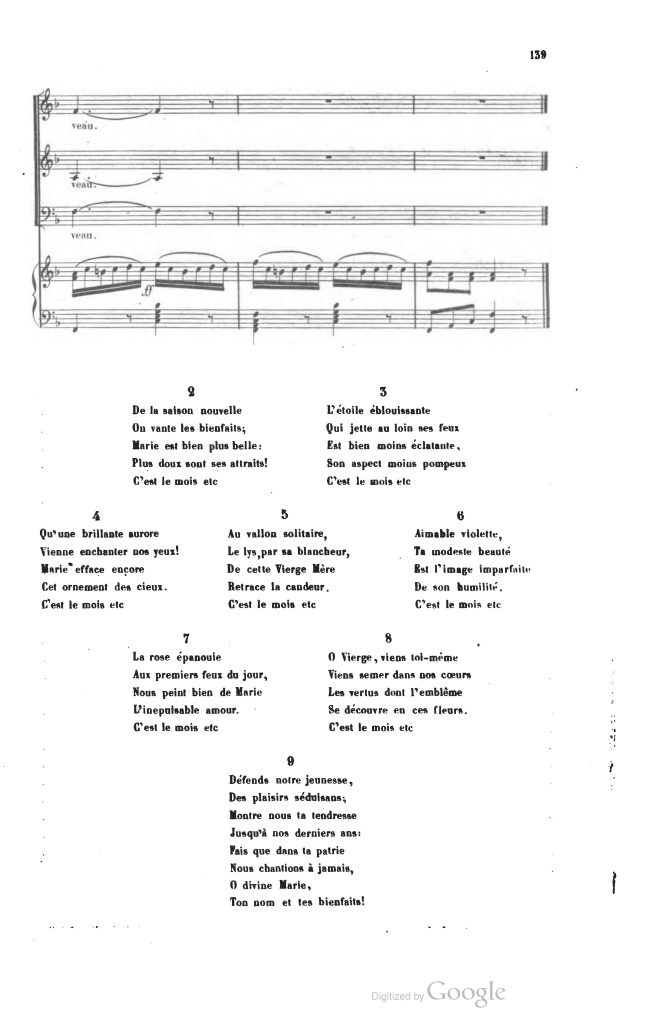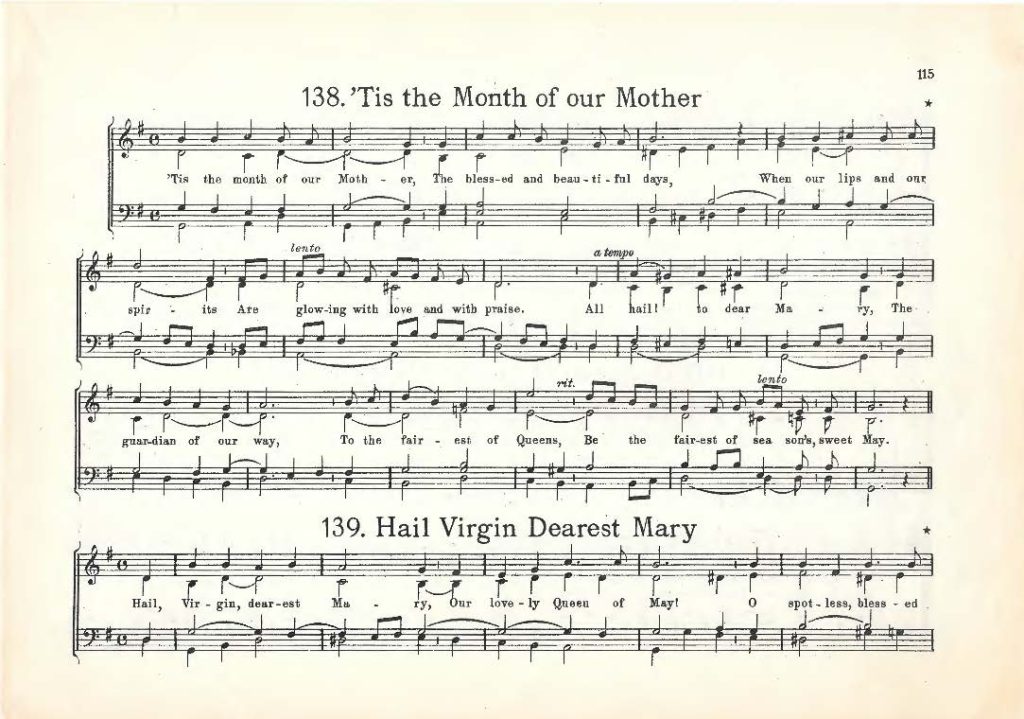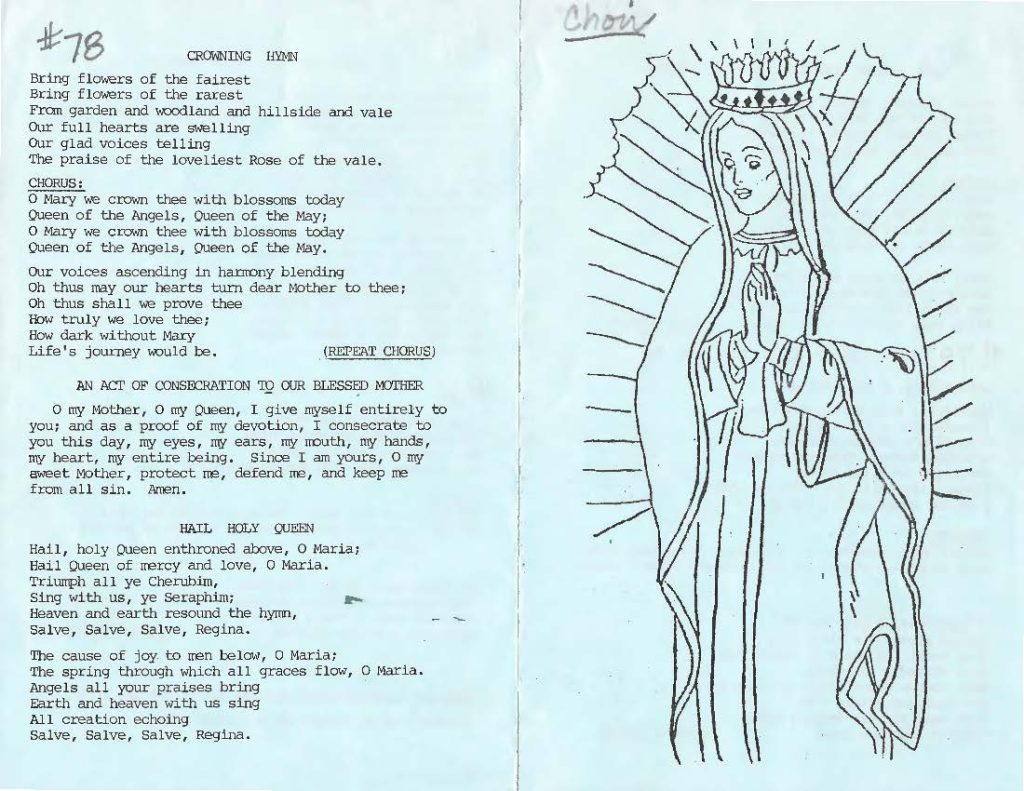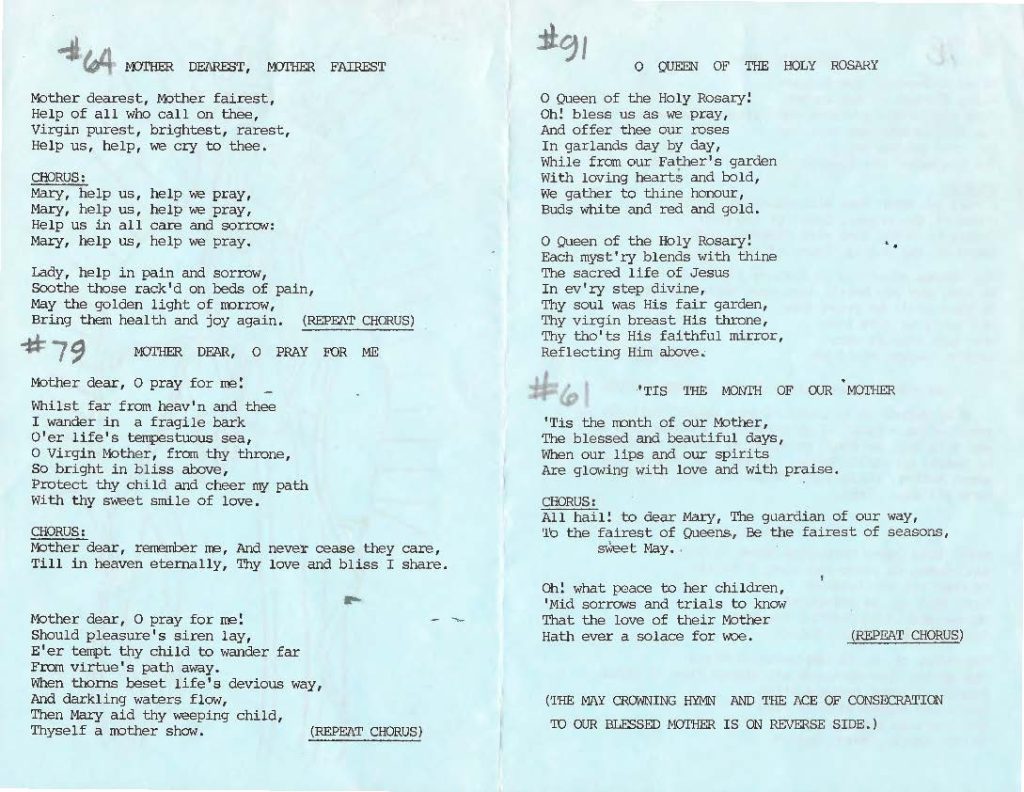Eleanor Cecilia Donnelly (1838-1917) is the author of this hymn. This poem that became a hymn was written when she was a young child or perhaps as a young adult. It did not appear in Catholic hymnals until around 1860. The hymn would appear many years later in a collection of her poems Crowned With Stars, published in 1881 by Notre Dame University, Indiana. The poem which became a hymn would go on to become one of the most beloved devotional hymns for the month of May being sung by church choirs, sodality groups, in May processions, home devotions, and schools. (Click on any image to enlarge)
Eleanor is also the author of more than thirty volumes of poetry, most of it from a Catholic perspective, and is the author of several works of fiction, as well as a biographer who wrote the memoirs of Father Felix Jospeh Barbelin, S.J, and Sister Mary Gonzaga Grace of The Daughters of Charity of St. Vincent De Paul.
I have written before about Eleanor Donnelly’s life, so if you would like to learn more about her, please visit the HYMN OF THE MONTH write-up Daughter of a Mighty Father. I will briefly mention a few highlights. Eleanor was an educated woman and along with her sister could translate both French and German. She was known to have a full rich voice trained at its best with clear enunciation and a woman of charm. She was described as the Adelaide Procter of America by Archbishop Ryan of Philadelphia and was honored by two Popes for her sacred poetry, especially to the Sacred Heart of Jesus. She published a collection of original hymns to Sacred Heart in 1883 and 1912 and carefully chose the melodies for each of them.
Eleanor was born in Philadelphia, the sixth child of Dr. Philip Carroll and Catherine Gavin Donnelly. Her elder brother, Hon. Ignatius Donnelly, ex-Lieutenant Governor of Minnesota, was the first to recognize his little sister’s poetic gift. She wrote her first poem when she was eight years old and published a hymn to the Madonna, in a child’s paper, at the age of nine. She was a contributor to several Catholic magazines and newspapers including the Ave Maria. By the turn of the twentieth century, the Ave Maria was the most popular English-language Catholic magazine in the world. The magazine was published on Sundays until 1970.
She was for a time chief editor of the magazine, Our Lady of Good Counsel, conducted by the Augustinian Fathers. In The Catholic Standard and Times, a Catholic weekly of Philadelphia with which she was connected for some time as associate editor, much of her work appeared, even as late as a month before her death. She spent her final years among the Sisters of the Immaculate Heart whom she dearly loved and died one April morning on the Feast of St. Catherine Siena, the name she took upon entering the Third Order of St. Dominic. The Sisters honored her by wrapping her in the Dominican habit that she so highly prized. Her contributions to Catholic literature and her publications are too numerous to mention.
As indicated above, the earliest appearance of the hymn is found in THE CATHOLIC VOCALIST, 1860 compiled by Henry T. Rocholl. THE CATHOLIC VOCALIST was a small periodical of sacred music consisting of litanies, anthems, motets, and hymns for churches, schools, and private families. This collection of sacred music highlights Marian hymns from THE SACRED WREATH.
THE SACRED WREATH and the first May devotions in the United States.
The Sodality of the Blessed Virgin Mary, is the oldest sodality in the United States as well as May Devotions fostered by members of the Jesuit Order, had a huge impact on religious practices of this country. The first May Devotions held in this country occurred at Georgetown University in 1830. The first American parish Sodality of the Blessed Virgin Mary was founded in Philadelphia in 1841 by Father Felix J. Barbelin, S.J., (1808-1869). Father Barbelin was beloved by the city of Philadelphia who regarded him as the Apostle of America. It was Father Barbelin who first made the singing of Catholic hymns popular in Philadelphia and also established what would become May Crowning’s and May Processions in this country.
Father Barbelin was born in Luneville, France, and came to the United States where he joined the Jesuit Order in 1831. As a young priest he desired to go west as a missionary to the Indians, but became pastor of Holy Trinity Church, Georgetown, and a professor at Georgetown College. In 1838, he became pastor of St. Joesph’s Church in Philadelphia where he served for twenty-five years. During his pastorship, he founded St. Joseph’s Hospital and in 1852, he was named president of St. Joseph’s College.
Father Felix Barbelin prepared the first Manual for the Sodality. This Manual contained the Office of The Blessed Virgin, the Office for the Dead, the origin and rules of the sodality, and various prayers. The Sodality gradually developed a collection of hymns. The hymns began as a small private collection that would eventually be published as THE SACRED WREATH in 1844 by Eugene Cummiskey.
THE SACRED WREATH saw several editions which included an appendix of hymns, these were added by Father Edward Sourin, S.J., in 1863 and 1867. Father Sourin was born in Philadelphia to Irish Catholic parents, both of whom died when he was still quite young. The children were placed in foster care and separated. Edward was the youngest and was adopted by Catholic friends, however his brother was less fortunate and was adopted by a Protestant family, he grew up and became a Methodist minister. Edward faired much better and was sent to St. Mary’s College, Emmittsburg. He excelled in his literary studies, became fluent in Latin, Greek, French, and wrote poetry with ease and grace.
In 1851, Father Sourin become an assistant at St. John the Evangelist Church in Philadelphia. He established a St. Mary’s Sodality in 1852 and became Vicar-General of the diocese. He was then appointed pastor of the Philadelphia Cathedral and joined the Jesuit Order in 1855. In 1859, he was once again pastor of St. John the Evangelist Church when the church was turned over to the Jesuits. Some of his poems became hymns and appeared in the Second Revised Edition of THE SACRED WREATH. These include O blest forever the mother; For all that seek her holy shrine; and possibly As the dewy shades of even. It is not known whether Father Sourin or another rearranged the hymn Mother Dear, O Pray for Me, by Issac Woodbury.
There is more that I could write about both of these humble priests but that is beyond the scope of this write-up. So, check back often to read my HYMN OF THE MONTH series where I’ll feature more details on these two priests in future hymn write-ups.
No music was provided by the editors of THE SACRED WREATH, but some hymns had their melodies indicated suggesting they could be sung to known airs. The Preface says these were chosen because they would be familiar to singers. The hymn, ‘Tis the Month of Our Mother first appeared in the appendix of the 1863 edition.
Copies of the 1863 and 1867 editions are extremely rare. A copy of the 1877 third edition is shown above, and the hymn is found in the appendix (see below) captioned Hymn to our Blessed Mother.
Other hymnals:
In addition to the Catholic Vocalist and the Sacred Wreath, the hymn ‘Tis the Month of Our Mother appeared in more than twenty hymnals. The hymn gained its widest use through the St. Basil’s hymnal rather than the original source or any other hymnal. A complete list of the hymnals can be downloaded by clicking on the link provided here. Tis the Month of Our Mother – Hymnal Survey
Melodies
The melody for this hymn, which has become the traditional melody, was composed by Fr. Louis Lambillotte, S.J., (1796-1855) a composer, publisher, and a leader in the restoration of Plain Chant. The melody is based on C’est le mois de Marie, meaning It’s the Month of Mary, a French sacred song to our Blessed Mother and can be found in Fr. Lambillotte’s 1842 and 1867 Choix de Cantiques, a collection of sacred hymns. I also found one other melody in the SURSUM CORDA hymnal prepared at the request of Ven. Mother Gerard, Provincial Superior at Stella Niagra, New York, and published in 1925.
Reflection
This is one of my favorite hymns and St. Mary’s Choir would often sing this hymn during the Marian months of the year and for the parish May Crowning. I was fortunate to be part of a wonderful group of choir members, many of my friends have long since departed for their final reward. In 1982, St. Mary’s Parish in Akron, Ohio held its annual May Crowning. A program was printed up for this special outdoor event which was attended by many parishioners.
I made a recording on a cassette tape of the hymns, and I saved the program which I now share with you. The cassette tape of the May Crowning has seen better days and frankly I am surprised it still plays at all. I extracted the hymn ‘Tis the Month of Our Mother’ and include it in the playlist below. With the exception of a handful of parishioners like myself, the hymns listed in this program will be new to many of the parishioners now attending St. Mary’s.
In the first verse of ‘Tis the Month of Our Mother, the hymn speaks of the blessed and beautiful days, and for St. Mary’s parishioners this is true, we just completed the installation of a brand-new roof for the church, a new school science lab was completed, a Marian meditation garden is about to be installed, and a downstairs bathroom in the church has been renovated, with many more projects and events scheduled to begin. So, indeed we have reasons for our lips and our spirits to glow with love and praise.
I think today we don’t sing hymns to our Blessed Mother as often as we should. I have observed musically speaking, that we pretty much keep to the seasons and if it’s not the season, we tend to forget about her. If the only time you told your own mother that you loved her was on her birthday, or Christmas, or Easter, I don’t think you would have a particularly good relationship with her. When I sang with the choir, we always had a Marian hymn to sing before Mass or during Mass. There was no special occasion or event, we sang the hymns, just because, because we love Our Mother.
Hymns are a most effective way for the congregation to express this love and so we should sing them more often; the verses also teach me about the doctrines of our faith. So, be spontaneous and ask your organist or music director to incorporate more Marian hymns into your Sunday Mass and you’ll see what a wonderful relationship you will have with your Mother and with her Son! Take a moment to reflect on these beautiful verses and look for the blessed and beautiful days in your life.
Be sure to read about the most widely used May Crowning hymn – Bring Flowers of the Rarest.
Copies of the Sacred Wreath from 1844 and 1877 and the photographs of Father Barbelin and Father Sourin, I am indebted to the Georgetown University Archivist. Many thanks to the Villanova Falvey University Librarian for helping with an interlibrary loan of the Sacred Wreath Second Edition.
A special thank you to Peter Meggison producer of the Devotional Hymns Project for allowing me to link to a recording by the Seraphim Singers at Holy Name Church, Boston.
Also, to Noel Jones, AAGO in granting permission to link to A Catholic Book of Hymns and Chants with nearly three hundred time-honored traditional Catholic hymns, including ‘Tis the Month of Our Mother. You can download A Catholic Book of Hymns & Chants FREE at www.sacredmusiclibrary.com

